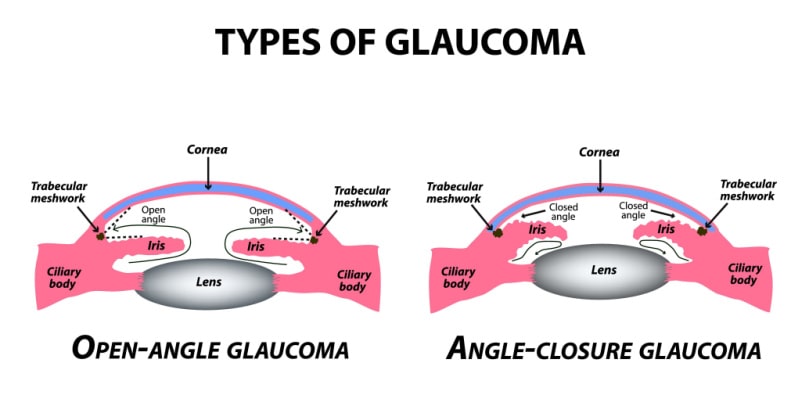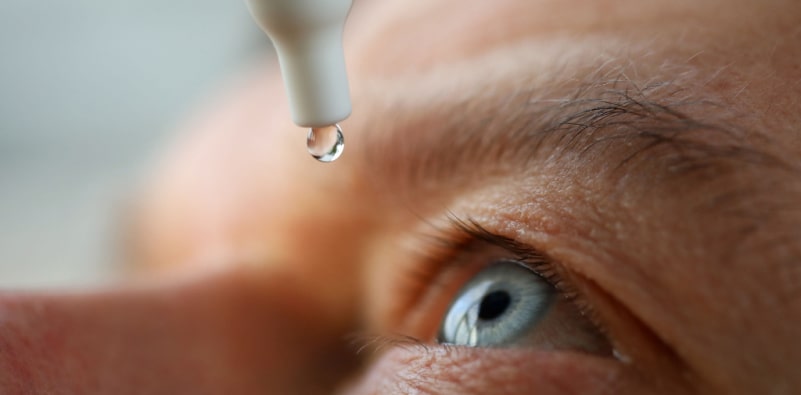Glaucoma – causes, symptoms, and treatment
Glaucoma is the term given to a group of eye conditions that occurs when the optic nerve at the back of the eye becomes damaged. The most common cause is due to excessive pressure caused by intraocular fluid, but it is possible for it to occur when pressures are normal.

The optic nerve carries all the visual information to the brain for processing, so plays a fundamental role in how well we see. The damage caused is irreversible and can lead to sight loss if left undiagnosed and untreated.
Glaucoma affects around 1-2% of the UK population over 40 – nearly half a million people.
What are the symptoms of glaucoma?
Known as the “silent thief of vision”, most types of glaucoma typically have no noticeable symptoms in their initial stages, and because the peripheral vision is usually affected first, it can often go undetected for a long time.

This is the case with primary open angle glaucoma. Sight loss starts with blind spots on the outer edges and gradually narrows until you’re essentially looking through a tunnel. If left untreated, blind spots can affect your central vision too.
Acute close angled glaucoma occurs when your eye pressure rises very suddenly, causing damage over a short space of time. You may experience blurry vision, halos around lights, red, painful eyes, and even nausea.
Who is at risk?
People who may be at risk of glaucoma include:
- those over 40 years old – it is rare below the age of 40 and risk increases with age
- people with either high or low blood pressure
- people with African-Caribbean and East Asian origin
- anyone with a close blood relative with the condition are 4 times more likely to develop glaucoma
- diabetics
- short sighted people are more at risk of developing primary open angle glaucoma
Staying one step ahead

Glaucoma can be managed – and the earlier this is done, the better. As mentioned, it is asymptomatic in its early stages, so attending your routine eye test is best way to identify it before it causes more permanent damage. An eye pressure test is a standard part of comprehensive eye exams and can help us diagnose glaucoma.
There are also other pieces of advanced diagnostic equipment we have invested in to help detect and monitor glaucoma.
The OCT is essential for early detection as it instantly produces a complete 3D image showing your retinal tissue and optic nerve at the back of your eye.

By examining this, we can accurately determine exactly where and to what extent the optic nerve is damaged. This is non-invasive and can be done along side your standard eye exam if requested.
The Humphrey Field Analyser is also non-invasive and is specifically designed to check if you’re missing any of your peripheral or central vision.
If you experience any of the close angled glaucoma symptoms, you should contact us immediately for an emergency appointment so we can check your eyes and refer you for hospital treatment straight away if needed to avoid permanent vision loss.
Treatment for glaucoma

Special eye drops to reduce pressure are the most common way to manage the condition. They are typically used long-term or for life. We can refer you to an ophthalmologist who can prescribe them and monitor your eye pressure regularly to see how well the drops are working.
If your eyes don’t respond to the drops, laser treatment might be recommended, or in advanced cases, surgery may be undertaken to help fluid drainage.
For acute closed angled glaucoma, you’ll be able to get hospital treatment straight away that lowers your eye pressure, thus preventing permanent vision loss.
Request an eye test
If you’re in one of the higher-risk groups, or have any symptoms of glaucoma, you can request an appointment online, or contact us directly on 01484 713291 and one of the friendly team from our opticians in Brighouse will be on hand to help you get booked in for your peace of mind.
 01484 713291
01484 713291 7 Bethel Street, Brighouse, HD6 1JR
7 Bethel Street, Brighouse, HD6 1JR
